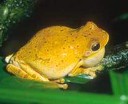| Tlalocohyla | |
|---|---|
 | |
| Tlalocohyla loquax | |
| Scientific classification | |
| Kingdom: | Animalia |
| Phylum: | Chordata |
| Class: | Amphibia |
| Order: | Anura |
| Family: | Hylidae |
| Subfamily: | Hylinae |
| Genus: | Tlalocohyla Faivovich , Haddad , Garcia , Frost, Campbell, and Wheeler , 2005 [1] |
| Species | |
See text | |
Tlalocohyla is a genus of frogs in the family Hylidae, [2] [3] also known as rain treefrogs or Middle American yellow-bellied treefrogs. They occur in Middle America between Mexico and Costa Rica. [2] This genus was created in 2005 following a major revision of the Hylidae. The five species in this genus were previously placed in the genus Hyla . [1]